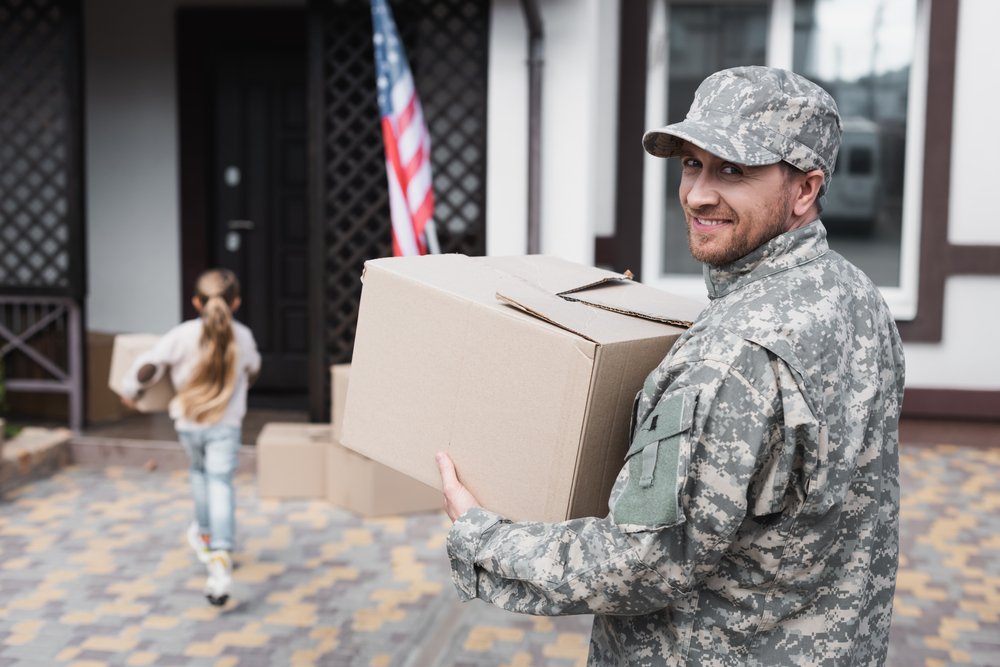The Department of Defense (DoD) has always been committed to ensuring that its service members and their families experience smooth transitions during relocations. One such initiative is the Personally Procured Move (PPM) program, formerly known as the Do-It-Yourself (DITY) Moves.
This program empowers military personnel to take charge of their relocation process, offering flexibility and potential cost savings. Instead of relying solely on the DoD-arranged Transportation Service Providers, individuals can opt to manage or even perform their move.
Whether you’re considering a full or partial move, understanding the intricacies of the PPM can be invaluable. This article delves deep into the PPM program, shedding light on its benefits, processes, and how it can be a game-changer for military relocations.
Preparing for a Personally Procured Move
The journey of a Personally Procured Move (PPM) begins with meticulous preparation. This phase ensures that the move is not only efficient but also compliant with the Department of Defense’s guidelines.
1. Getting Approval from the Transportation Office
Before embarking on a PPM, it’s crucial to get the green light from the local transportation office. This office serves as a bridge between the service member and the defense personal property system. By obtaining approval, you ensure that your move aligns with the DoD’s regulations and that you’re eligible for potential reimbursements.
The transportation office plays a pivotal role in guiding military members through the nuances of a PPM. From understanding the intricacies of weight tickets to providing insights into the defense personal property system, their expertise is invaluable. It’s always recommended to liaise with them early to avoid any hiccups later.
2. Understanding Entitlements and Allowances
Every service member has specific entitlements and allowances when it comes to relocation. These can vary based on rank, duty station, and other factors. By understanding these, you can make informed decisions about your move and ensure you maximize your benefits.
Allowances can cover a range of moving expenses, from hiring a commercial moving company to purchasing packing materials. It’s essential to familiarize oneself with these to budget effectively. Moreover, understanding your entitlements can help in estimating the weight of household goods you’re allowed to move, ensuring you don’t exceed the authorized household goods weight.
3. Estimating Costs and Potential Reimbursements
One of the advantages of a PPM is the potential for reimbursements. By estimating your moving expenses and comparing them with the actual cost reimbursement offered by the DoD, you can gauge the financial feasibility of your move.
While a PPM offers flexibility, it’s essential to remember that not all costs might be covered. For instance, while the transportation of a privately owned vehicle might be part of the move, its costs might not be fully reimbursed. Hence, having a clear estimate helps in making informed decisions and ensuring you’re prepared for any out-of-pocket expenses.
4. Choosing Between DIY or Hiring a Moving Company
The beauty of a PPM is the flexibility it offers. Service members can choose to move their belongings themselves (DIY) or hire a commercial moving company. Each option has its pros and cons, and the decision often boils down to personal preference and the estimated weight of the move.
While a DIY move offers more control, it might be time-consuming. On the other hand, hiring a moving company can ease the burden but might be more expensive. It’s essential to weigh the benefits of each option against its challenges to make the best choice for your circumstances.
5. Necessary Documentation for a PPM
Documentation is the backbone of a successful PPM. From weight tickets to receipts, maintaining a thorough record ensures a smooth reimbursement process and serves as evidence in case of disputes.
The defense personal property system requires specific documents for a PPM claim. These might include receipts from the moving company, weight tickets, and other relevant paperwork. It’s advisable to liaise with the local transportation office to understand the necessary documentation and keep it organized throughout the move.
Read More: Navigating School Changes During PCS Moves: A Guide for Parents
The Step-by-Step PPM Process
Embarking on a Personally Procured Move is a journey that requires careful planning and execution. By understanding each step of the process, service members can ensure a smooth transition to their new duty station.
1. Initial Planning and Research
Before diving into the move, it’s essential to lay a solid foundation. This involves understanding the defense personal property system, researching potential moving companies, and gauging the estimated weight of your belongings.
Research is the cornerstone of a successful PPM. Whether it’s understanding the nuances of the defense personal property system or comparing quotes from different moving companies, a well-researched plan ensures a hassle-free move. Moreover, by gauging the estimated weight of your belongings, you can avoid any surprises later on.
2. Securing Packing Materials and Equipment
Packing is a critical phase of the move. Using the right materials and equipment ensures the safety of your household goods and can prevent potential damages.
Whether you’re moving fragile items or bulky furniture, having the right packing materials is crucial. From bubble wrap to sturdy boxes, investing in quality materials can make a world of difference. Moreover, if you’re opting for a DIY move, securing equipment like dollies or moving trucks can ease the transportation process.
3. Packing Your Belongings Safely
Once you have the materials, the packing process begins. This step requires meticulous attention to detail to ensure that every item, from fragile glassware to bulky furniture, is packed securely.
Packing might seem daunting, but with a systematic approach, it becomes manageable. It’s advisable to start with non-essential items and gradually move to daily-use goods. Labeling boxes, creating an inventory, and ensuring fragile items are cushioned can prevent damage and make the unpacking process smoother.
4. Transportation: Renting a Truck vs. Using a Personal Vehicle
The transportation phase is where your belongings move from the old location to the new one. Depending on the volume of goods and personal preference, service members can choose between renting a truck or using their personal vehicle.
While renting a truck might be suitable for a larger move, using a personal vehicle can be cost-effective for smaller relocations. It’s essential to consider factors like the distance of the move, the estimated weight of the belongings, and potential moving expenses before making a decision.
5. Weighing Your Shipment: Importance and Process
Weight plays a pivotal role in a PPM. It not only determines potential reimbursements but also ensures compliance with DoD regulations. Hence, weighing your shipment accurately is of paramount importance.
Before and after the move, it’s essential to get weight tickets for your shipment. These tickets serve as evidence of the weight of your belongings and are crucial for the reimbursement process. Moreover, staying within the authorized household goods weight limit ensures you don’t incur additional expenses.
6. Submitting Claims and Reimbursement Requests
Once the move is completed, the reimbursement phase begins. By submitting claims with the necessary documentation, service members can recoup some of the moving expenses.
The defense personal property system requires specific documents for processing a PPM claim. These might include weight tickets, receipts, and other relevant paperwork. By submitting these in a timely manner and liaising with the local transportation office, you can ensure a smooth reimbursement process.
7. Unpacking and Setting Up at the New Location
The journey of a PPM culminates with the unpacking phase. Once your belongings reach the new location, it’s time to set up your new home.
Unpacking might seem like a daunting task, but with a systematic approach, it becomes manageable. Using the inventory created during the packing phase can help in organizing the items. Moreover, setting up essential rooms like the bedroom and kitchen first can make the transition smoother.
8. Dealing With Damages and Insurance Claims
Despite meticulous planning, damages can occur during the move. In such cases, having insurance and understanding the claim process can be invaluable.
Whether it’s a broken vase or a scratched piece of furniture, addressing damages promptly is essential. By liaising with the moving company and submitting insurance claims with the necessary documentation, you can ensure a fair resolution.
Tips and Best Practices for a Successful PPM
A Personally Procured Move, while offering flexibility, requires meticulous planning and execution. By following best practices and being aware of potential pitfalls, service members can ensure a smooth relocation.
1. Organizing and Inventorying Your Belongings
Before diving into the packing phase, it’s essential to organize and inventory your belongings. This not only makes the packing process smoother but also aids in the unpacking phase.
An organized move starts with decluttering. By getting rid of unwanted items, you can reduce the estimated weight of the move and potentially save on moving expenses. Moreover, creating an inventory of your belongings ensures you have a record of every item, making the unpacking process and any potential insurance claims easier.
2. Ensuring the Safety of Fragile Items
Fragile items like glassware, electronics, and artwork require special attention during the move. By packing them securely and using the right materials, you can prevent potential damage.
Whether it’s using bubble wrap, packing peanuts, or specialized boxes, investing in quality packing materials can make a world of difference. Moreover, labeling boxes as ‘fragile’ and ensuring they’re loaded securely can prevent any mishaps during transportation.
3. Efficiently Loading the Moving Truck
Loading the moving truck efficiently ensures the safety of your belongings and can prevent potential damages. Whether you’re doing a DIY move or hiring a moving company, understanding the nuances of loading can be invaluable.
The key to an efficient load is balance. By placing heavier items at the bottom and lighter ones on top, you can prevent potential damage. Moreover, using straps and ropes to secure items can prevent them from moving during transportation, ensuring their safety.
4. Understanding and Abiding by DoD Regulations
The Department of Defense has specific regulations for Personally Procured Moves. By understanding and abiding by these, service members can ensure a compliant move and maximize potential reimbursements.
From weight limits to documentation requirements, the DoD has specific guidelines for PPMs. By liaising with the local transportation office and familiarizing oneself with these regulations, you can avoid any potential hiccups and ensure a smooth move.
5. Keeping All Essential Documents Handy
Documentation is the backbone of a successful PPM. From weight tickets to receipts, maintaining a thorough record ensures a smooth reimbursement process and serves as evidence in case of disputes.
Whether it’s the defense personal property system or the local transportation office, various entities require specific documents for a PPM. By organizing these and keeping them handy, you can ensure a hassle-free move and a smooth reimbursement process.
6. Planning for Unexpected Delays and Challenges
While meticulous planning can ensure a smooth move, unexpected delays and challenges can arise. By being prepared for these, service members can navigate them effectively and ensure a successful relocation.
Whether it’s a delay in the moving truck’s arrival or unexpected weather conditions, various factors can disrupt the move. By having a contingency plan and being flexible, you can navigate these challenges effectively and ensure a smooth transition to your new duty station.
7. Seeking Assistance and Resources From Military Support Groups
Relocation can be daunting, but you’re not alone. Various military support groups offer resources and assistance to service members embarking on a PPM.
From understanding the nuances of the defense personal property system to getting insights into the reimbursement process, these support groups can be invaluable. By seeking their assistance, you can ensure a well-informed and smooth move.
Read More: How to Choose the Right Storage Services During a Military Move
Why Choose Our Service at Military Movers?
At Military Movers, we pride ourselves on being more than just a moving company. We are a dedicated team that understands the unique challenges faced by military personnel and their families during relocations. Our services are tailored to ensure that every move is as seamless, efficient, and stress-free as possible.
Tailored Solutions for Military Families
- Personalized Moving Plans: Every move is unique, and we treat it as such. Whether you’re relocating within the country or overseas, we create a custom moving plan that caters to your specific needs.
- Advanced Tracking Technology: Our state-of-the-art satellite tracking technology ensures that you can monitor your shipment in real-time, giving you peace of mind.
- Expertise in Military Relocations: With over two decades of experience, we have a deep understanding of the intricacies involved in military relocations, ensuring a smooth transition every time.
Beyond Just Moving
- Storage Solutions: Whether you need temporary storage or a long-term solution, we offer both, including climate-controlled options for sensitive items.
- Packing and Unpacking Services: Our experts are trained to handle all your packing and unpacking needs, ensuring that your belongings are safe and secure throughout the move.
- Dedicated Support: Our team is available round the clock to answer any queries and address concerns, ensuring you always have someone to turn to.
Serving All With Excellence
While our primary focus is on serving military members and their families, we extend our exceptional services to non-military customers as well. No matter who you are, if you’re looking for professional moving assistance, Military Movers is here to help.
Conclusion
Relocating, especially for military personnel, can be a daunting task. With so many moving parts, it’s easy to feel overwhelmed. However, with the right support and guidance, this process can be made much more manageable. Military Movers is dedicated to providing that support.
With our tailored services, advanced technology, and a team of experts, we ensure that every move is smooth and stress-free. If you or someone you know is planning a move, reach out to us.
Let Military Movers make your transition seamless. Contact Military Movers today and experience a hassle-free move!
FAQs
The PPM program, formerly known as the Do-It-Yourself (DITY) Moves, allows military personnel to manage or even perform their move, offering flexibility and potential cost savings.
Military Movers offers a range of services, from packing and unpacking to storage solutions, ensuring that those opting for a PPM have all the support they need for a successful move.
Absolutely! While we specialize in serving military members and their families, we extend our top-notch services to non-military customers as well.
Our deep understanding of the unique challenges faced by military families during relocations, combined with over two decades of experience and advanced tracking technology, sets us apart. We offer tailored solutions to ensure every move is seamless and efficient.
You can reach out to us directly, and our team will provide a free, no-obligation quote based on your specific moving needs.




